In the interest of full disclosure, I must confess that I am a huge fan of the Bell 407. Truth be told, it’s one of my three favorite aircraft — fixed-wing or helicopter. So it should come as no surprise that I was more than a little excited when I was invited to fly Eagle Copters Ltd.’s Eagle 407HP — which replaces the stock 407’s Rolls-Royce C47 engine with a Honeywell HTS900D-2-1D for more power for “hot and high” operations. The company received a supplemental type certificate (STC) for the conversion from Transport Canada on Dec. 9 (approval from the United States Federal Aviation Administration came less than two weeks later), and I was at the controls on Dec. 17.
Mating the HTS900 to the 407 airframe is not an original idea — it was the basis for Bell Helicopter’s ARH-70 armed reconnaissance helicopter, and a proposed civil variant, known as the Bell 417, developed about a decade ago. However, both programs were eventually cancelled, with the failure of the civilian variant blamed on rising development costs and too big of a delta between its required sale price and that of the existing 407.
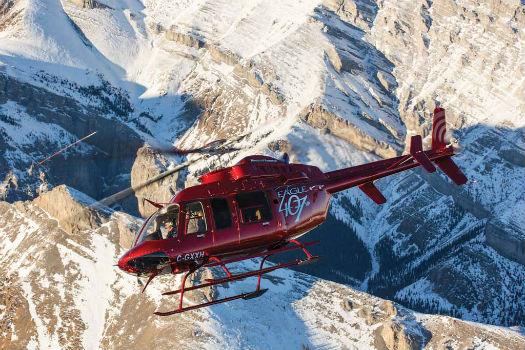
Vertical test pilot Guy Maher flies the Eagle 407HP in Calgary.
Despite this setback, the project had shown tremendous promise, registering strong interest from the helicopter community. Recognizing the opportunity — and its ability to complete such a conversion process — Eagle Copters of Calgary, Alta., began work on what was to become the Eagle 407HP. The company has been in the helicopter sales and leasing business for 40 years, but has also developed a reputation for its ability to do some exciting transformations to existing airframes (such as its Eagle Single, which converts the Bell 212 to a single Honeywell T53-17 –powered airframe). It began the long STC process for the 407HP conversion in March 2009, and received the full support and cooperation of both Bell Helicopter and Honeywell.
Some may ask why the 407, reputed to have pretty good power as it is, needs even more. But when the temperature and/or terrain climbs, certain operators have found the venerable helicopter could use a little more muscle. This has caused the conundrum for some Bell fans of having to decide if they struggle with their favorite airframe in the hot and high, or shuffle over to the competition — namely the Airbus Helicopters AS350 B3 — so they can have the necessary power to get the job done. With the HTS900D-2-1D offering 820 shaft-horsepower (s.h.p.) at takeoff, over the C-47’s 650 s.h.p., the 407HP is pitched as the solution to this problem.
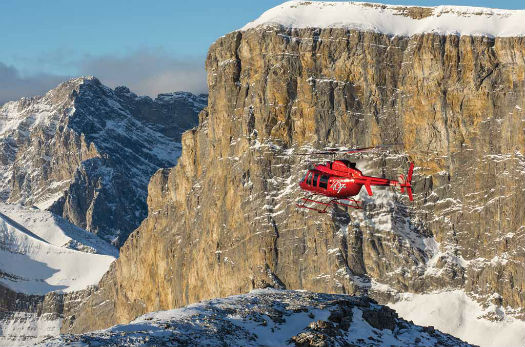
At 10,000 feet, with an outside air temperature of -5 C (23 F) and 80 percent torque (out of an available 93.5 percent), the 407HP indicated a respectable 120 knots, especially considering the high skid gear, bear paws, and external mirrors.
And, while anyone requiring an increased power reserve margin, such as parapublic operators with a hoist or external load, will feel the benefit of the 407HP, it is indeed up high that the 407 HP really comes into its own. This quickly becomes apparent when you compare various performance charts for the stock 407 versus the 407HP, with the latter offering far more takeoff and hover power — and it’s worth noting that Eagle Copters actually flew the charts. They are not interpolated.
The hover out of ground effect (HOGE) scenario I posed to the charts was a pressure altitude of 10,000 feet, outside air temperature (OAT) of 20 C (68 F), heater off, anti-ice off, basic inlet. The stock 407 chart said the gross weight limit was approximately 4,300 pounds (1,950 kilograms); for the 407HP, this increased to approximately 5,150 lb. (2,336 kg).

The test ship Vertical flew will certainly be in its element hauling skiers into the high country with Yellowhead Helicopters.
Just for fun, I grabbed an AS350 B3 rotorcraft flight manual (RFM) and ran the same problem. The result was approximately 4,650 lb. (2,109 kg). Using the new Bell 407 flight manual supplement (FMS-12) for a top performing C-47 engine, I was able to justify an increase to 4,620 lb. (2,095 kg) — but this was still over 500 lb. (227 kg) shy of the 407HP.
So, on paper, the 407HP clearly excels. This should be no real epiphany. Put a monster engine with 22 percent more power into a helicopter with no additional changes to the drive train limits and yes, it should lift more.
But this is a pilot report, not a chart reading exposé. So let’s go fly it.

The proven four- blade rotor system and associated drive train remain the same with the HP conversion.
Cold and High
For hot weather testing, December in Calgary is, admittedly, not ideal. The high part, however, would be easy. Just west of Eagle Copters’ base is the beautiful Kananaskis mountain range. Yes, I know one doesn’t need mountains to test performance at high altitude, but it sure is more dramatic!
Although I didn’t have the advantage of a hot day, I did have the advantage of a stock Bell 407, which was made available to me along with the Eagle 407HP. So the order of the flying day would be to load both 407s to roughly equal weights, (the 407HP wound up being about 100 lb. heavier), then conduct the same performance checks in each one.
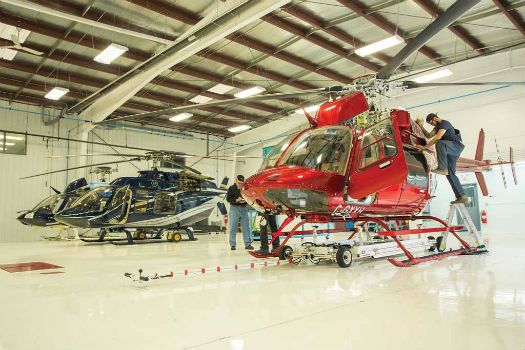
The 407HP (red, foreground) is prepared for Vertical’s flight, while a stock 407 (background) is ready to receive the HP conversion treatment.
In preparation for my test flights, it was appropriate to spend some time going through the 407HP’s flight manual supplement (FMS). (Miserable weather the day before my test flight gave me plenty of time for review.) A very nice touch is that Eagle Copters incorporated all the relevant information from the basic 407 RFM into the 407HP FMS. In essence, a separate RFM was created for the 407HP, meaning the pilot doesn’t have to refer back to the original RFM. The FMS is assembled in the same five-section arrangement as conventional RFMs, and any unchanged paragraph or section from the original 407 RFM is set over an ivory-colored background.
One note: the Bell Kit 407-706-020, which allows the internal gross weight maximum to be increased to 5,250 lb. from the standard 407 limit of 5,000 lb., is required for this STC. So if it’s not already installed, Eagle will do it along with the conversion. (Both aircraft still share the same 6,000 lb. limit when lifting external loads.)
The RFM also revealed that I was going to have to get used to seeing higher measured gas temperature (MGT) readings with the HTS900 over those of the original C-47 engine. The Honeywell just runs hotter and, accordingly, has higher top-end temperature limits. Main rotor torque (TQ) limits remain the same.

The author at the controls of the 407HP. Another tough day at work! Guy Maher Photo
My in-flight guide would be Paul Schreuder, Eagle Copters’ director of helicopter sales. I won’t describe the flight in the stock 407. Rather, I’ll include the comparative test results where appropriate.
The outward appearance and preflight of the 407HP is nearly identical to the 407. One telltale physical difference is the bulge in the top of the engine cowling to accommodate the Honeywell engine. The more obvious differences show themselves when entering the cockpit — and of course, when flying the machine.
The panel is different in that the original eight Litton gauges are replaced by Diamond J gauges. These are in same position and represent the same relative information as the standard 407 gauges they replace; it’s just a different — but very easy to read — presentation style. On startup they go through a self-test and tell you what software version is currently incorporated.
They will also tell you — by flashing — if there was an exceedance. Only cycles on the power turbine and gas turbine from the most recent flight are displayed. However, a full history and running counts are stored in FADEC (full authority digital engine control) memory.
And speaking of the FADEC, the one in the 407HP is a true dual-channel FADEC, with no manual mode. The aircraft will also come with fire detection systems as standard.
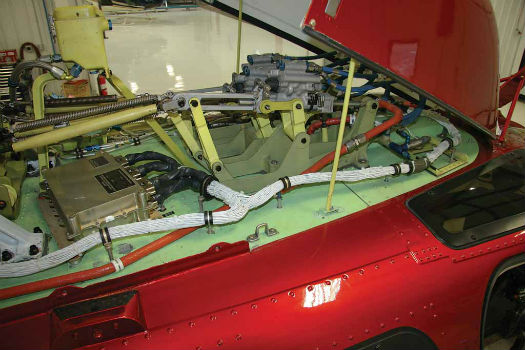
The new dual channel FADEC occupies the same mounting space as the single channel unit it replaces. Guy Maher Photo
Starting up
The 407HP throttle feels a little different from the stock 407. It’s a mechanical linkage and feels a little “gritty” at the top end approaching the “fly” detent. We were utilizing power from the auxiliary power unit (APU) due to our extended ground running of the electronics (for my educational benefit) prior to the start.
As expected, the 407HP started quick and cool on the APU. You hold the starter switch and it takes under a second of delay before you feel it engage, upon which you can release the switch. Your job is to simply monitor the start and roll the throttle off if needed.
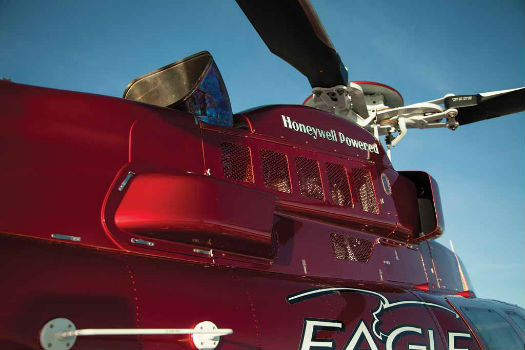
The top cowling bulge is the predominant clue that there is something different under the skin.
For my start, the MGT went to 600 C (977 C is the maximum for the start). Schreuder said it would have gone to 750 C on the current version of the battery used. (Eagle is developing a different battery with more starting amperage that will provide for cooler starting.) The start light went out at 50 percent NG, and the idle range is 58 to 64 percent NR (ours was 64).
One new pre-takeoff checklist item is the FADEC reset test switch. Here you are testing the FADEC reset function. Should you get any FADEC warning lights while in flight, you have the ability to do a FADEC reset by pressing that switch.
After the preliminary hydraulic check, I rolled the throttle to the “Fly” position. And fly it does! I expected both ships to feel the same at the lower level of the takeoff from the Eagle pad (approximately 2,500 feet above mean sea level) — but with a little pull on the 407HP collective and just the smallest amount of forward cyclic, we were gone. It was certainly more robust and with less pitch and pull than I used on the stock 407 departure. This goes to show that you don’t have to get much above sea level before the advantages kick in.
Before we get into the actual recorded performance data, I want to mention that the ambient conditions for both flights were about as identical as one can get. The only difference was in OAT from time to time. And even that didn’t vary by more than one degree.

The Honeywell HTS900D-2-1D fits nicely in the space vacated by the original C-47 engine, with its alignment exactly matching the Bell-defined coordinate system.
The first order of performance business was a timed climb. At 90 knots and 90 percent torque on the stock 407, which also put us just about at our MGT maximum continuous power (MCP) limit, we turned in a timed climb of 1,734 feet per minute (FPM). With 86 percent torque being pulled on the 407HP, we still had a 40-degree buffer on MGT, and the climb rate clocked in at 2,100 (FPM). (Then I looked down and remembered the 2,000 FPM climb rate limitation on any 407… Oops!)
For the cruise check, the stock 407 bested the HP by a few knots. However, the stock 407 was a clean corporate-configured ship on low skid gear. As you can see from these photos, the 407HP was decked out with mirrors, high skid gear, and bear claws in preparation for its delivery to Yellowhead Helicopters for heli-skiing.
In any case, the stock 407 at 10,000 feet indicated 125 knots at 80 percent TQ and 16 degrees shy of the MGT MCP limit. For the 407HP, at 80 percent TQ we indicated 120 knots and with a 46-degree MGT buffer. Fuel burn for cruise of 234 to 249 pounds per hour should be expected at altitudes from 5,000 to 10,000 feet.
For my HOGE tests, we stabilized at 10,000 feet with an OAT between -6 and -7 C (21 and 19 F). With the heater off, the stock 407 required 61 percent TQ, and was using 87 percent of its allowable MGT limit. The 407HP displayed 52 percent TQ, using 79 percent of its allowable MGT limit.

Eight new Diamond J gauges replace the stock panel set. They incorporate the new engine’s operating limitations, talk to the FADEC, and maintain commonality between all indicators for easy pilot recognition. Guy Maher Photo
With the heater on, the stock 407’s TQ was the same at 61 percent, but the MGT climbed to 92 percent of its allowable limit. In the 407HP with the heater, on I saw a two percent rise in TQ to 54 percent, and the MGT increased to using 81 percent of its allowable limit.
A few additional notes on performance are that even in the winter conditions I experienced, the allowable weight boost is appreciable. The 407HP would be allowed to handle 5,650 lb. (2,563 kg), with 400 lb. (181 kg) of that load being external. For the stock 407 the weight limit was 5,100 lb. (2,313 kg). The stock 407 using the FMS-12 supplement was 5,350 lb. (2,427 kg), with 100 lb. (45 kg) of that load being on the hook. And the B3 was 5,100 lb. (2,313 kg).
Also, Schreuder told me that summertime testing in Leadville, Colo., put the 407HP at maximum gross weight and in a 50-foot OGE hover; it climbed out of it vertically, and they didn’t exhaust tail rotor authority. “The FAA test pilot flew the ship backwards at 70 knots, which is double the normal 35 knot limit,” Schreuder added.
With my performance testing done, it was time for me to join up with the camera ship for the photo shoot. Throughout the entire session, which consisted of considerable HOGE work and maneuvering with a full range of power requirements, Schreuder never called out TQ or MGT readings to me that came even close to requiring any corrective moves. Clearly, there is no disputing the considerable reserve power afforded by the 407HP, and the buffers this allows. And, with the photo shoot completed, it was time to head back to the base.
After landing and the two-minute cool down, I noticed that once the 407HP’s NG gauge falls below five percent, the cycle count is displayed. You then wait another second or two, then dry motor the engine for 10 seconds (this doesn’t register a cycle), and only when this is complete do you use the rotor brake. This action makes a significant difference in engine longevity (as it brings cool air through it), with a corresponding increase in the life of the rotating components. And by not applying the rotor brake until after the dry motoring, you don’t have nearly the starter/battery load to do the run. This task fit into the shutdown flow nicely.

The author in an out of ground effect hover, where he found the 407HP had considerably more power margin versus the stock 407 he flew earlier the same day.
Making the modification
I have to admit I was surprised by the amount of work involved in performing the modification that turns the Bell 407 into an Eagle 407HP. So often, modifications through STC are a “bolt this on, add this piece, change that part” type of an event. Not so with the 407HP. This is a full-blown production — not just an engine swap with some new gauges.
After the entire tail boom and landing gear skids are removed, the fuselage is rolled into an engine alignment fixture on the dolly via tracks in the fixture. Various alignment plates for the engine, transmission, and tail boom serve as hard points on the fixture. These provide alignment at the exact waterline, butt-line and station values to correctly line up the aircraft in the Bell-defined coordinate system.
Once the transmission is removed, the original C-47 engine comes out, along with six associated caution/warning/advisory annunciators that are replaced with new annunciators applicable to the HTS900-2-1D engine.
Given that the 407HP sports a true FADEC system, there is no requirement for a mechanical linkage to the engine. All engine control is routed through three primary electrical harnesses. A new dual-channel FADEC is installed in the same location as the removed component.
Eight new Diamond J gauges replace the stock panel set. This is required due to the specific programing contained within the instruments allowing them to “talk” with the new dual-channel FADEC. They also incorporate the new operating limitations, while maintaining commonality between all indicators for ease of pilot recognition.
The engine cowl is modified to allow the inlet ducted air access to the engine inlet, located at the top of the engine. It also allows the engine burner to extend slightly above the previously existing profile of the engine cowl. This also helps cool the engine bay.
I’ve hardly skimmed the surface of all that’s involved. But this process, which is not required by the STC, is all in the interest of achieving a single goal — ensuring consistency. Eagle Copters wants every 407HP to come out identical.
And as such, the 407HP conversion will initially only be done by Eagle Copters. In addition to its main Calgary location, the company will be able to perform the conversion at its two satellite locations — one just outside of Santiago, Chile, and the other in Coffs Harbour, Australia.
Pricing for the kit is US$795,000 and it will add 70 to 90 pounds, depending on individual customer setups. Eagle Copters said the installation requires around 1,000 man hours, which equates to 30 days of downtime. The company offers a trade-in allowance for the aircraft’s original C-47 engine — if the customer chooses. Of course, the trade value depends on the time and condition of that engine.
In terms of future applications, Schreuder said the company has “a great deal of interest” in transferring the application process to the 407GX. “We believe that customer demand will soon show us, Bell and Garmin the need to apply the HTS900 to the 407GX.”
Indeed, customer demand is already robust for the basic 407 conversion. And why shouldn’t it be? The Canadian and United States governments have just allowed a top performing workhorse to legally go on steroids.





